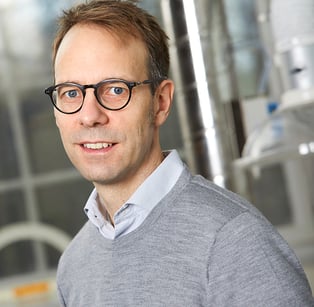JoVE in Action is a series of blog posts highlighting how STEM educators around the world have used JoVE to support their remote teaching efforts. We hope these stories will be useful for instructors looking for effective ways to deliver their science and lab courses online or in hybrid formats.
Dr. Peter Dinér is an Associate Professor of Organic Chemistry at the KTH Royal Institute of Technology in Stockholm. Having learned about JoVE after one of his colleagues published a video article in JoVE Journal, Dr. Dinér began to use some of JoVE’s organic chemistry videos in his lab classes, incorporating them into the lab journal. This enabled his students to both read about and visualize the procedures that they would perform in the laboratory.

Dr. Peter Dinér
When his institution decided to move to virtual classes, Dr. Dinér decided to use JoVE videos to replace the different practical tasks that students would ordinarily perform in the lab. At the time, he was teaching a second-year organic chemistry bachelor course for students in the chemical engineering master’s program. The labs for this course covered the basic concepts and practice of organic chemistry, including topics like lab safety, distillation, carbonyl chemistry, and more. For the carbonyl chemistry lab, for instance, Dr. Dinér assigned students videos like Introduction to Catalysis, Organocatalysis, Performing 1D Thin Layer Chromatography and Rotary Evaporation to Remove Solvent.
Additionally, Dr. Dinér found it helpful that each video in JoVE Science Education came with associated quiz questions about the content covered by the videos, accessible by clicking on the ‘Create Quiz’ button under the videos. “I used the quizzes related to each JoVE video to check if the students had understood the practical tasks and concepts of the videos,” he said.
He also created lab journal assignments related to risk assessment, flow charts of the procedures demonstrated in the videos, and mechanisms of the chemical reactions. To make the JoVE videos easy for his students to access, he included QR codes to the videos in their lab compendium, alongside instructions for the lab. In other cases, he embedded the videos into Canvas, the institution’s learning management system.
Both Dr. Dinér and his students found the videos helpful. “In my previous evaluations, roughly half of the students watched the videos when they were not mandatory,” he said. Dr. Dinér also noted his students’ massive usage of JoVE for remote learning, with several videos — such as those on Fractional Distillation, Redox Reactions and Melting Point — each being viewed close to or more than 100 times by members of his institution in the spring semester alone. Moreover, compared to spring last year, the institution saw up to a 9,600% increase in the usage of certain JoVE videos — a result of the increased integration of the videos into courses like Dr. Dinér’s.

